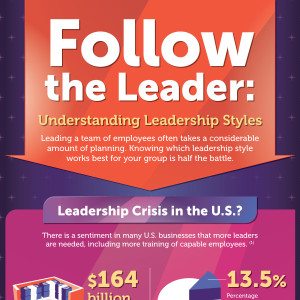Follow the Leader: Understanding Leadership Styles
Leading a team of employees often takes a considerable amount of planning. Knowing which leadership style works best for your group is half the battle.
Leadership Crisis in the U.S.?
There is a sentiment in many U.S. businesses that more leaders are needed, including more training of capable employees. (1)
$164 billion
Amount spent on training and development in 2012
13.5%
Percentage of that money spent on leadership development
56%
Percentage of employees who admit to being disengaged, a problem that can be solved with effective, involved leadership.
54%
Percentage of U.S. employees who say there are not enough leadership successors in place at their work. This means only about one-third of businesses are preparing to train new leaders.
88%
Percentage of employees who say that receiving praise from a manager was "very" or "extremely" rewarding
Styles of Leadership
Autocratic (2,3,5)
What it is: Leaders make decisions alone without the input of others. They possess total authority over those below them.
When to use it: When snap decisions need to be made in a time of crisis.
Strengths: Can show authority to employees and make quick fixes.
Weaknesses: Autocratic leaders are often disliked and employees may feel frustrated and stifled that their opinions are worthless.
Famous example: Steve Jobs
Laissez-faire (2,3,6)
What it is: Offering little supervision or input to employees, allowing them to make most and sometimes all decisions on their own.
When to use it: When there are many experienced, highly trained workers on your staff.
Strengths: Experienced workers feel more satisfied and free to be creative.
Weaknesses: Offers little training to new or struggling employees, leading to loss in production and a high turnover rate.
Famous example: Herbert Hoover
Participative (2,3,4)
What it is: Leaders run a semi-democracy, where employee input is taken into consideration although the final decision rests with the leader.
When to use it: When valuable input from employees is needed in a situation that involves everyone.
Strengths: Employees feel trusted and free to express themselves.
Weaknesses: Sometimes there is too much listening and employee input with little action on their concerns.
Famous example: Donald Trump
Transactional (2,3,4)
What it is: Leaders and employees set predetermined goals with each other, and leaders provide rewards or punishments to employees for either reaching or failing to reach said goals.
When to use it: This style works best with teams that do well when motivated and offered incentives for performance.
Strengths: Employees feel compensated for their hard work.
Weaknesses: There is a large focus on performance numbers, which is not always an indicator of a good worker.
Famous example: Joseph McCarthy
Transformational (2,3,4)
What it is: Leaders and team members are involved in one goal that is based on the "big picture."
When to use it: When a large goal needs to be met by the entire company.
Strengths: Employees feel important, working with leaders to accomplish the same goal. It strengthens the sense of comradery among the team.
Weaknesses: Leaders may micromanage employees when working closely with them or delegate too many tasks.
Famous example: Martin Luther King Jr.
SOURCES:
1. http://www.quantumlearn.com
2. http://smallbusiness.chron.com
3. http://www.educational-business-articles.com
4. http://www.brighthub.com
5. http://www.chaseteron.com
6. http://www.adviseamerica.com

